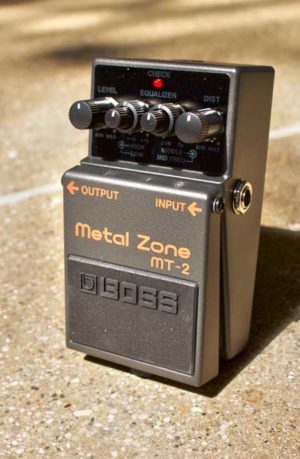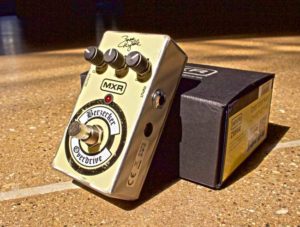When you think of metal, the most barbarous of metal, Southern California isn’t exactly the place that comes to mind….that is, until the emergence of Slayer. Legions of fans can’t help but bellow out the sinister-sounding name to show their devotion – SLAYER!!! Though polarizing, their sound was just as much brutal and original as it was influential and the band has since earned a spot in the “big four” of thrash metal bands alongside Metallica, Megadeth and Anthrax. Despite controversy, they’ve sold over 20 million albums worldwide and earned 5 Grammy nominations and 2 wins, no doubt cementing their place in history as one of the most important metal bands of all time.
Early Years
Hailing from Huntington Park, CA, the band was formed in 1981-82 by guitarist Kerry King. Reportedly, drummer Dave Lombardo had heard from his friends that a local musician, King, had played guitar a few blocks away from where he lived, and later introduced himself. They realized they both had similar tastes and interests in music, and gelled well as musicians. Eventually, King met and brought on board guitarist Jeff Hanneman and former bandmate and singer/bassist Tom Araya to complete the famous early lineup. To get their start on the scene, the band hit the Southern California club and party circuit playing covers from classic punk and metal bands like Iron Maiden and Judas Priest. After a time, they were eventually picked up by Metal Blade Records founder Brian Slagel, who invited Slayer to record an original for the Metal Massacre III compilation album he was planning to release on his label, which did well in getting their name out there locally.
The band was awarded a recording contract and released their debut album Show No Mercy, which featured fast tempos influenced by hardcore punk and power metal and a lo-fi quality that contributed to its reception by fans. Terry Butler, bassist for the band Obituary as well as former bassist for seminal death metal band Death, deemed the album as “the blueprint for the beginning of death metal.”
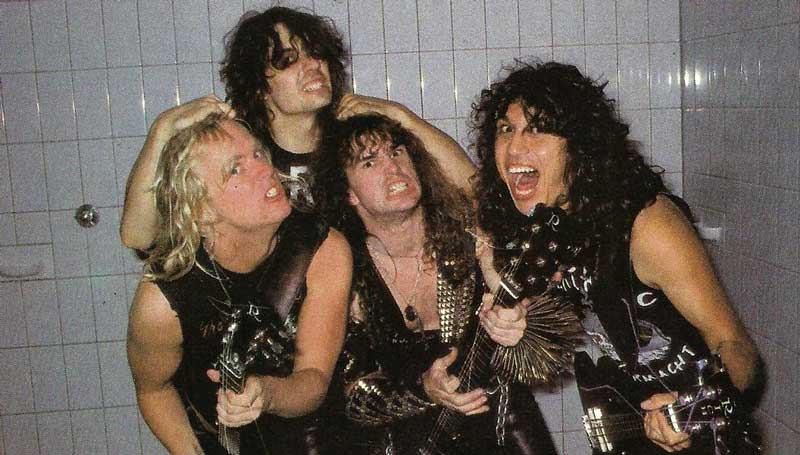
Slayer in their early days.
The album would go on to be Metal Blade Records’ highest-selling release – pretty impressive for a band touring out of Tom Araya’s Camaro with a U-Haul trailer in tow. They had sold between 15,500 – 20,000 copies in the US, and more than 15,000 overseas, leading Slagel to request a new EP and a full-length record. That record would become Hell Awaits, which contained a now-infamous demonic backwards-playing recording of the band saying, “Join us!” at the start of the album. Hell Awaits introduced fans to varying tempos and song structures different than Slayer’s previous recording, as well as lyrical content that emphasized torture and more Satanic imagery. You can still hear the punk influence on some of the riffs, but the band was pushing in a distinctly more brutal and progressive direction. Fans could not get enough of their brand of metal, because no other band seemed to be quite as heavy, fast, or starkly merciless as they were.
What came next though, would change the world of metal for good.
Reign in Blood
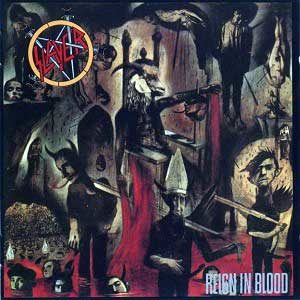
the classic 1986 album Reign in Blood
1986 saw the release of Slayer’s most famous album, Reign in Blood, which was a departure once again from its predecessor in a few important regards. Most essential was Slayer’s choice to collaborate with producer Rick Rubin at Def Jam Records. Rubin had never worked with a heavy metal band at the time, leading to apprehension from band manager Brian Slagel, who felt it may not be a great move having the band join what was then a primarily hip-hop-oriented label. To many this seemed an unusual direction to be heading in.
But Hanneman was surprised by Rubin’s interest in the band, already familiar himself with Rubin’s work producing LL Cool J and Run DMC’s albums. Besides, Rubin was so eager to work with them that they agreed to the album collaboration. His contributions to their sound pushed the tempos even faster, and Rubin encouraged the band to tighten up the length of their songs. The band agreed, due to their growing desire to not compose songs of mostly repetitive riffs. On top of that, Rubin’s skill as a producer made their album’s sonic production value the most professional it had ever been, which gave clarity to their riffs and helped to showcase their skill as musicians and maturing songwriters.
Reign in Blood clocks in at a meager 29 minutes, not even filling one side of a cassette tape. This was due to the album’s average tempo of around 220 beats per minute, which is insane even by today’s standards. Producer Rick Rubin had expressed concerns over this short length, but the band was satisfied with it – they felt the more extreme tempos were a representation of the sound and style that they wanted to progress toward. Something about an album so fast it was almost untenable was appealing to them.
Because of the band’s imagery and lyrical content, Reign in Blood received no radio airplay — yet it still managed to enter the Billboard 200. It debuted at #127 with a peak position of 94 after its sixth week. It was certified Gold in the US. Slayer would later go on to release 5 albums with Gold chart status.
“If you released Reign in Blood today, no one would give a shit. It was timing; it was a change in sound. In thrash metal at that time, no one had ever heard good production on a record like that. It was just a bunch of things that came together at once.”
– Kerry King
Needless to say, the album is considered one of, if not the most influential and heavy thrash metal albums ever recorded.
South of Heaven
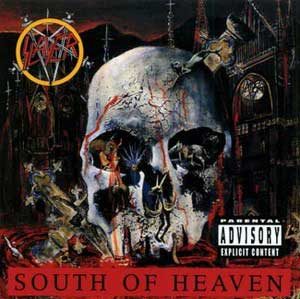
1988’s South of Heaven
Once Reign in Blood was released, the band found themselves in several binds: drummer Dave Lombardo had decided to call it quits after the conclusion of the tour to support the album. He had stated that he felt he wasn’t making enough money with the band, despite the album’s success. Slayer also began to run into creative problems: how could they possibly top the intensity and speed of Reign in Blood? They had decided that it was nearly impossible, and instead made a conscious effort to slow down the tempos of their new music and use a different approach. This became their fourth full-length album South of Heaven. Unfortunately, the fans and critics alike churned out ambivalent opinions on the slower and more melodic direction that their music was heading in.
In a sense, the band had defied the fans’ expectations that they were always going to remain the fastest and most brutal band around, which led to feelings of disappointment with the new album. The band themselves were also unsure of the final product, but acknowledged that South of Heaven eventually did grow on most of the fans. The charts reflected this – the album made it all the way up to #57 on the Billboard charts. It’s still a classic album in the Slayer canon, no doubt about that.
The Gear
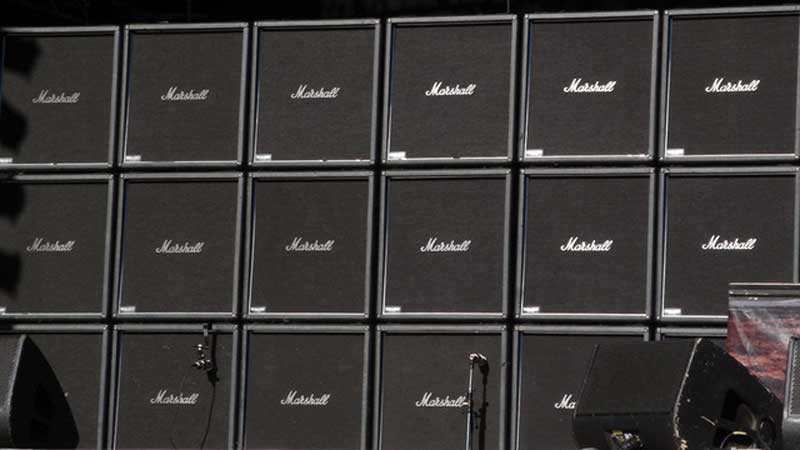
Jeff Hanneman’s live amp setup
King and Hanneman’s guitar rigs from this era were fairly straightforward, mostly relying on volume and power rather than intricate gear choices to achieve their sound. For instance, King’s rig on Reign In Blood was reportedly a Marshall JCM 800 head with Marshall 1960 4×12 cabinets. From there, he used a Boss 10-Band EQ with the sliders set in an upside-down “V” shape, boosting the mids rather than scooping them as is common in metal. King has said that he sets his amp tone controls as such: Bass between 4-6, Mids around 8, Treble around 6-7, and Presence around 7. His preamp gain is set to 8-9 with his master volume varying depending on the venue. King has also added that he gets a lot of gain from the Boss EQ, which can hit the front end of his amp pretty hard and increases his gain saturation levels. It is said that at this time he was playing B.C. Rich Warlock guitars, equipped with what was thought to be Dimarzio Super Distortions (possibly a Megadrive, but most sources report that didn’t happen until their South of Heaven album. They later switched to EMG 81/85s). Hanneman was playing a quite similar rig, featuring a B.C. Rich Bich guitar, a Marshall JCM800, and a Boss EQ pedal as well.
Our Video
For our video, we had certainly wanted to capture the intensity and ethos of the band, both musically and aesthetically. It can be hard to imagine just how absolutely savage those early Slayer albums are when looking at them from a 2017 mindset, but all of the album bans, burnings, and religious uproar the band attracted definitely show how ill-prepared the world was for their music then.
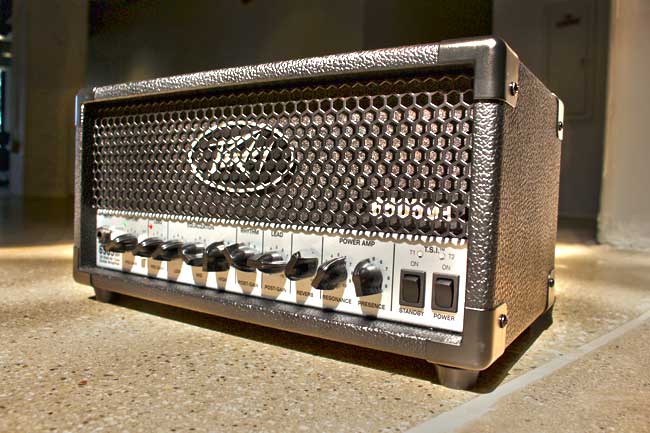
Peavey 6505 Plus Mini Amp Head
We had to use modern equipment to get a great ’80s-era metal tone, and decided to go with a compact choice – the Peavey 6505 Plus 20-watt head and matching Peavey 1×12 cab for our amp, with an ESP LTD Arrow 401 guitar to round things out (not literally though – this thing is called the Arrow after all). It’s a wonderfully simple setup, and one that can get you through most of their catalogue pretty easily. As an alternative (or if you prefer more gain), check out the varieties of Ibanez Tube Screamers, or something like a Boss Metal Zone or MXR Zakk Wylde Berserker Overdrive (which Kerry King uses in his rig these days) if you’d like a different flavor to pair with your amp. Because the Peavey 6505+ is capable of outputting much more gain than the Marshall JCM800 amps Slayer was using in the 80’s, we only had to run the amp on the Rhythm channel, with a very low gain setting. We needed more of a full-bodied crunch tone to work with rather than an all-out oversaturated distortion tone. In 1986-88 Slayer were using a little bit less gain than you might have initially thought. Be sure to give your amp an extra good boost in those mids for the full effect.
I wanted to do a short medley of a few famous tunes, so some obvious choices popped out: “South of Heaven” and none other than “Raining Blood”. The downbeat riffage of South of Heaven is nicely juxtaposed with the insane speed of “Raining Blood” and worked well to show both sides of the band’s sound.

ESP LTD Arrow 401
Musically speaking, the riffs are similar in that they both exploit the tritone musical interval with descending chromatic sequences interwoven in. From there, each song utilizes lots of palm mutes, a necessity of metal music, and plenty of power chords, which is a colloquial term for an octave interval with a fifth in-between.
- Boss MT-2 Metal Zone
- MXR Zakk Wylde Berserker Overdrive
King and Hanneman also enjoy playing harmonized lead lines, likely due to their old appreciation for bands like Iron Maiden. You can clearly hear this technique displayed on the intro riffs to both tunes. I’d have to say my favorite riff is found in “Raining Blood” towards the middle of the video, which is the fastest riff in the song. It is lovingly referred to as the “spider crawl” lick, and for good reason – the finger pattern looks like a spider crawling about. To wrap up the video, we ended with a nice Kerry King-inspired solo complete with some whammy abuse and a bit of shred to boot.
Untimely Demise

Jeff Hanneman
We had chosen to feature the classic lineup of Kerry King and Jeff Hanneman, as this is the original lineup that created the famous tunes we had featured in our video. As many of you know though, Jeff Hanneman tragically passed away on May 2nd, 2013. He had reported to have been at a friend’s house near Los Angeles relaxing in a jacuzzi when he felt a sharp bite, thought to be from a spider, that caused necrotizing fascitis in his arm. This condition, also known as “flesh-eating bacteria” is a bacterial infection that spreads quickly and eats through the body’s soft tissue. The infection was so severe doctor’s were considering amputating his arm to stop the spread of the disease. They fortunately reconsidered and decided to administer large doses of antibiotics while monitoring him closely. This condition left him unable to play in the band, which they thought would be temporary, and hired Exodus guitarist Gary Holt to fill in for him.
From there things got worse – Jeff had been unable to play in his band, and turned to alcohol to help him cope with the loss of playing guitar. To make matters worse, his father passed in 2008, when he initially had began drinking more heavily. The loss of music only exacerbated his struggles, and he eventually succumbed to cirrhosis of the liver at age 49. Later that night on the day of his death, King broke the news of Hanneman’s passing at the Revolver Golden Gods Awards ceremony alongside their mutual friend Zakk Wylde to a stunned audience. To honor his friend though, they had a “moment of noise”, stating that Jeff would’ve much preferred it to the customary moment of silence.
While Jeff’s passing is indeed incredibly saddening, we are fortunate to have his legacy cemented in his music with Slayer. He was the brainchild behind the famous songs “Angel of Death,” “Raining Blood,” “War Ensemble,” “Dead Skin Mask,” and many others. I think I speak for all of us at zZounds when I say that we dedicate our video to Hanneman, and Slayer as a whole, for their unmistakable contributions to the world of metal. May he rest in peace.

